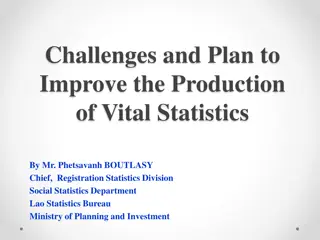Understanding Business Statistics: Introduction, Origin, and Meaning
Business statistics is a vital discipline that involves the collection, classification, summarization, and interpretation of data for informed decision-making. Originating from ancient times with a focus on political states, statistics is essential in converting data into valuable information. It is characterized by numerical statements of facts, influenced by multiple causes, and requiring reasonable accuracy. Statistics can be analyzed both in a plural and singular sense, emphasizing the importance of systematic data collection and analysis techniques.
Download Presentation

Please find below an Image/Link to download the presentation.
The content on the website is provided AS IS for your information and personal use only. It may not be sold, licensed, or shared on other websites without obtaining consent from the author. Download presentation by click this link. If you encounter any issues during the download, it is possible that the publisher has removed the file from their server.
E N D
Presentation Transcript
1 Business Statistics B.Com 1stSemester BB.COM IST PRESENTED BY, DR VANDANA PANDEY ASSOCIATE PROFESSOR DEPARTMENT OF COMMERCE HCPG COLLEGE VARANASI
Statistics Introduction Statistics is generally used to mean quantitative aspects of data management but as a subject of study it refers to body of principles and procedures developed for collection, classification, summarization and meaningful interpretation and for the use of such data. Introduction The discipline is useful in converting random data to understandable information and aids in strategic business decision making. Statistics has its origin in Latin word Status, Italian word Statista and German term Statistik all of which mean PoliticalState . In ancient times the beginning of Statistics was made to meet the requirements of State primarily and hence the name. Origin The term Statistics is generally used in 2 senses- 1.Plural Sense Meaning 2. Singular Sense 2
Statistics Meaning-Plural Under this, the Statistics refers to numerical statement of facts related to any field of enquiry such as data related to income, expenditure, population etc in the sense of numerical data or Statistical data. Plural sense Definitions- Statistics are numerical statements of facts in any department of enquiry placed in relation to each other -Bowley Definitions for Plural sense By statistics we mean quantitative data affected to a marked extent by multiplicity of cause - Yule and Kendall 1. Aggregation of facts- A single number does not constitute Statistics as no conclusion can be drawn from it. Only the aggregate of facts capable of offering meaningful information constitute Statistics. 2. Numerically expressed- numbers. Qualitative data like rich, poor, beautiful, big etc cannot be termed Statistics. Features in Plural Sense Statistics are expressed in Contd .
Statistics Meaning-Plural 3. Affected by Multiple causes- Statistics is not impacted by only 1 factor as multitude of factors influence it. For e.g rise in prices can be attributed to reduction in supply, increase in demand, rise in input costs etc. 4. Reasonable Accuracy- A reasonable degree of accuracy must be maintaining while collecting the statistical data. 5. Placed in relation to others- Such data is called Statistics which is mutually related and comparable. Height of 40 people cannot be compared with age of 40 people as data is not related. 6. Pre-determined purpose- Data collected without any purpose or randomly will only be a numerical value and not Statistics. 7. Enumerated or Estimated- Data can either be collected by estimation (if the field of investigation is very vast) or enumeration (for smaller set of data). 8. Collected in systematic manner- Haphazardly collected data will not provide conclusive evidence so systematic collection should be planned beforehand. Features in Plural sense 4
Statistics Meaning-Singular Under this, Statistics refers to science in which we deal with techniques and methods for collecting, classifying, presenting, analyzing and interpreting the data in the meaning of Statistical methods. Singular sense Definitions- Statistics may be defined as the collection, presentation, analysis and interpretation of numerical data. -Croxton and Cowden Definitions Statistics is the science which deals with the collection, classification and tabulation of numerical facts as a basis for the explanation, description and comparison of phenomena- Lovitt Given the definitions, the following stages of Statistics emerge- 1. Collection of data- Decide how, where, when, what kind of data to be collected. 2. Organization of data- Organize the collected data to make it comparable and simple. 3. Presentation of data- Make the data intelligible, brief and attractive. 4. Analysis of data- To draw conclusions, analysis of data is required by different methods e.g. central tendency, correlation. 5. Interpretation of data- Comparison and conclusions in simple and easy language. Features in Singular sense 5
Statistics Scope The scope of Statistics may be classified into following 3 parts- The study of nature is to find out whether Statistics is Science or Art As a science- It studies the Statistical data As a Art- It makes use of data to solve problems of real life. Nature The subject matter of statistics is divided into 2 parts- 1. Descriptive statistics- It describes the data and consists of methods and techniques to explain characteristics of data. The methods can either be graphical or computational. 2. Inferential Statistics- It deals with methods which describe the characteristics of population or making decisions concerning population on the basis of sample results. Subject Matter Contd . 6
Statistics Scope 1. Study of Numerical facts-Statistics can only study such facts which can be expressed in numerical terms. 2. Study of Aggregates only- Statistics studies only the aggregates and not particular unit. No conclusion is possible from single piece of data. 3. Not the only method- Statistics is not the only method to study and many a time does not suggest the best solution of each problem. 4. Homogeneity of data- Quantitative data has to be consistent and homogeneous otherwise it will not be possible to draw conclusions. 5. Results are true only on an average- Statistical results only express tendencies and are true on an average and not absolutely. 6. Without reference results may prove wrong- Circumstances and conditions under which conclusions are made have to be studied otherwise the results may give wrong impression. 7. Can be used by experts only- Only experts can make good use of statistics and unqualified would find it difficult to apply it. 8. Misuse of Statistics is possible- The misuse of Statistics to seek particular results is a possibility, more so when it is not easily understood. Limitati ons 7
Statistics Functions 1. Expression of facts in numbers-One of the main function of Statistics is to express numbers in easily understandable language and interpret the results with certainty. 2. Simple presentation- Statistics enables presentation of complex data in a simple format in terms of aggregate, average, percentage, graphs, diagrams etc. 3. Enlarges individual knowledge and experience- Statistics expands the horizons of individual knowledge and understanding. 4. It compares facts- It facilitates the comparison of data and identifying the interrelations between large sets of data for drawing suitable inferences. 5. Facilitates policy formulation- interpretation of data, precise ascertained thus assisting policy formulation. 6. It helps other science in testing their laws- Statistics helps other laws for establishing their assumptions. E.g. Many laws of economics namely law of demand, law of supply, Keynes theory of employment can be verified by Statistics. 7. It helps in forecasting- Extrapolating present data aids in forecasting likely changes that can be expected in future. By doing analysis and nature of problem can be 8
Statistics Uses & Importance 1. Importance for administrators- Administrators use data for varied purposes and Statistics provide useful tools for decision making support. 2. Importance for business, industry and agriculture- Estimating demand and supply, studying seasonal changes, understanding trade cycles, consumer profiling, product life cycle analysis are examples of some of the functions that Statistics can perform for business, industry and agriculture. 3. Importance in Economics- Statistics is basis of Economics as it helps establishing the assumptions. Almost all the economic aggregates are measured with the help of Statistics. 4. Importance for Politicians and in Social field- For formulating social, economic, educational, industrial and other policies, politicians draw great support from Statistics discipline. Existing social problems can only be brought to fore front with the help of data analysis. The effectiveness of existing policies for social change can be measured by statistical tools. 5. Importance for banking and insurance industry- Bankers use statistics for estimating credit growth, risk analysis, portfolio management and insurers for establishing appropriate premiums looking at life expectancies. 9























